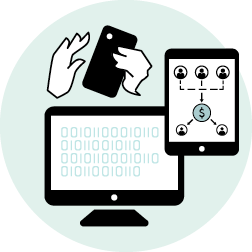You know the old saying: if you want something that’s fast, cheap, and good, think again. You can have two, but not all three.
Well, not usually. But if you use an enterprise resource planning (ERP) software, utilizing integrated payment processing may be the exception. As you’ll see, integration can save organizations time and money, improve employee efficiency and customer experience, while at the same time allowing companies to offer customers the payment options they prefer.
Financial Needs Drive ERP Implementation
ERP systems provide an integrated and continuously updated view of many aspects of a business, including revenue, expenses, customers, inventory, and orders, to name a few, with many extensions to address a broad range of types of businesses. Because of the value they can provide to a company and its operations, the ERP market continues to expand rapidly, with the total global market size expected to exceed $49.5 billion by 2025, according to one research report.
While different organizations have different reasons to implement ERP, financial needs are high on the list. In a survey of 255 companies looking to purchase ERP software, 89% identified accounting as the most critical ERP function.
Integrating payment processing into ERP allows transaction data from credit and debit cards and other electronic payments to automatically flow into the ERP system when a sale is completed or invoice paid. Without that functionality, a business must run external reports and manually enter data or import data into the ERP system. Not only does that mean duplicate efforts and delays in visibility to important information about your cash flow status, but there are also negative impacts to your customers.
Benefits of Integrating Payments and ERP
You may already have figured out that integrating payments with ERP must offer significant advantages. And you’re right. But to spell it out, some of those benefits are described here.
Improved accuracy and efficiency. Posting payments directly into your ERP simplifies the process and increases payment efficiency and accuracy in several ways. First, integration reduces manual entry of transaction data, decreasing the possibility of human error.
Second, returning customers don’t have to resubmit their information after the first time they use a payment method. Their preferred payment method can simply be selected within the software interface, making it much more convenient for customers to pay.
Finally, with less manual entry, employees have more time to focus on work that may be more valuable to the company and more interesting to them, potentially leading to greater job satisfaction.
Support for a wide variety of payment types. Multiple credit and debit cards, prepaid cards, ACH: all are available to customers for payments, and all can be integrated into an ERP. Card details also can be automatically updated if a customer replaces a lost or expired card, making cards-on-file or subscription payments convenient for customers and avoiding disruptions to revenue you’re counting on.
Reduced card processing costs. As we discussed in this blog post, payment card networks apply interchange fees to transactions to cover handling, fraud, and bad debt. While fees vary by card and transaction type, corporate and purchasing cards used in B2B and B2G transactions carry some of the highest interchange fees. However, a payment processing solution that integrates directly with your ERP can send more customer data along with every transaction, helping you to qualify for those lower interchange fees on a consistent basis.
Improved security. A built-in payment processing system offers the advantage of PCI compliant payment processing and tokenization, which together provide a high level of security for transactions. Tokenization means that data is useless to anyone trying to breach a system. And with less need for employees to handle sensitive payment card data, security improves.
Collection of more and better data. Integrating payments with ERP provides access to real-time data and reports to help companies run more efficiently. Up-to-date reports help an organization manage production, inventory, orders, and cash flow, which helps businesses make better operating decisions.
And speaking of cash flow, if you are using the right combination of ERP system and payment processor, you may see one final overall benefit: reduced days sales outstanding (DSO) and improved cash flow.
For example, MerchantE has an integrated payments relationship with NetSuite ERP that enables businesses to access specialized tools such as a click-to-pay link that is automatically added to invoices and quotes, enabling customers to easily pay online without any extra effort or intervention by the vendor’s employees.
Studies show that including a payment link in an invoice accelerates time to payment. Anything that automates and simplifies payments makes the process easier for both company and customers. Plus the payment is recorded in real-time right in the ERP system, giving users visibility into cash flow and reporting that guides their decision-making and follow-up efforts.
A Single Source of Truth
In information technology, a “single source of truth” means slightly different things to different people (if you believe Google). But bottom line, it generally refers to storage and management of data to avoid its duplication. Without a single source of truth, conflicting versions of information are all too likely, which can lead to poor decision-making, frustrated employees, and inconvenience for customers. By enabling payment processing within your ERP, you can escape those pitfalls. Instead, speedier processes, reduced card processing costs, complete data, efficient employees, and better-served customers – faster, cheaper, better – are all within reach.
Learn more about MerchantE’s payment processing innovations for NetSuite users




